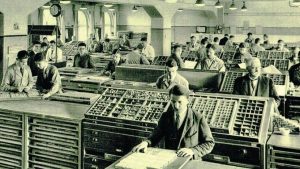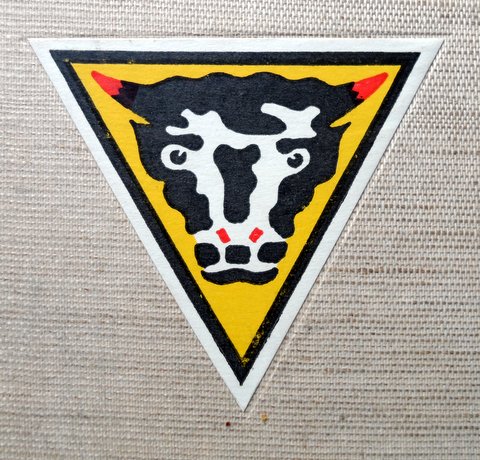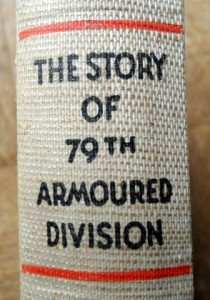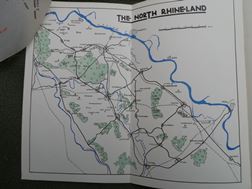Unique 1945 Hamburg book: the 79th and “Hobart’s Funnies”
In around 2013 I was given a unique, beautiful book, The Story of 79th Armoured Division: October 1942 – June 1945, published by the unit’s officers and men in July 1945 in the ruins of Hamburg, which they had just helped liberate. Since then, I have researched a fair bit and here is what I think I know, or can reasonably guess at…. Update: December 2017 brought a new hypothesis that Broschek of Hamburg may have produced the book (see below).
The 79th was an imaginative tank division under the leadership of Sir Percy Hobart, a general simultaneously admired as the grand old man of mobile warfare innovation and rather over-looked. A pioneer in WW1, and side-lined at the beginning of WW2, Churchill championed his return to influence and (after several other pioneering creations) Hobart produced the 79th and its “Hobart’s Funnies”. The latter were highly imaginative tank adaptations (most pre-dating the 79th’s formation), which saw them floating, bridge-laying, flame-throwing and much else, but also saw the development of all sorts of less armoured amphibian vehicles.
The 79th did not fight as a single entity, but lent its officers, men and equipment “under command” to other units, as they saw action from D Day, through France, Belgium, Holland and Germany.
The book was written by John (later Sir John) Borthwick, an old-Etonian who had been Sir Percy’s ADC and later one of his senior staff oficers. (Hobo was very fond of Borthwick, and thought the book well-written, considering it was by a man who had been “uneducated at Eton”.) Some other very talented people must have been at work on The Story of the 79th. As the pictures I post here show, its layout, font, photographs, (fold-out) full colour maps and illustrations all seem to be strikingly modernist. (See below for some speculations about its publication.)
Here’s a gallery of images of the book:
The book contains astonishing material: its text, maps, and data were assembled in very difficult circumstances but are as cool and comprehensive as though worked-on at leisure in a military college – or some university.
If you don’t want to pay up for a hardback first edition or a reprint (whose reproduction qualities I have no idea about), then – amazingly – it is to be had in a beautiful PDF version on DVD from Merriam Press in the US (I have one) and others.
Further research….
On the book’s typefaces: I was very struck by the typography in The Story of the 79th. It reminded me of high class American books from the WW2 period (I am thinking of Hendrik Van Loon’s books for Simon & Schuster, New York). A glance at Lewis F Day’s Alphabets Old and New (Batsford, c1910) made me think it might have been set in something which might have been designed by Franz Stuck (1863-1928). Looking at myfont.com nudged me toward the idea that it looked like Thannhaeuser Neue, designed recently by Ralf M Unger in tribute to Herbert Thannhaeuser (1898-1963). Luc Devroye – whose informative website I had only known for about five minutes – replied to my emailed request for information to say that the Story’s title-work at least was set in Thannhaeuser Schrift, 1929. There are elements of the Gothic and Modernism, and more, in this tale of a type.

I think this may be a photo of Broschek’s Hamburg works in which, plausibly, “The Story of the 79th…” was typeset… [From the Hamburger Abendblatt website]
On the book’s maps: I was very struck by the loveliness of the Story‘s maps, many of them fold-out. I asked Percy Hobart’s most recent biographer, Richard Doherty, about the creativity involved, and he replied:
Officers who had passed through ‘The Shop’ at Woolwich before the war were trained in drawing and were able to produce fine panoramas. This was considered especially important for artillery officers but also for sappers, both of whom were trained at Woolwich. Some, but not all, Royal Tanks officers were also Shop-trained and would have been able to draw panoramic sketches. Needless to say, all three were present in the division [the 79th] and on its staff. The maps etc. in the history show the hallmarks of such training.
On the book’s production: There is abundant evidence in Macksey’s biography that Percy Hobart loved books and writers. He commissioned or helped in the production of several histories of outfits he was interested in, both in the war and immediately after it. Amongst these were books on the Royal Tank Regiment, with illustrations by Hobart’s friend Eric Kennington, and a history of the Royal Hospital Chelsea, of which Hobart became Lieutenant Governor (1953-48).
It was, therefore, typical of Hobart that he might have organised much of the writing and publication of The Story of 79th Armoured Division. Here is Richard Doherty’s comment on its publication:
The production of The Story of 79th Armoured Division in Hamburg was not unique. There seemed to be a small industry in such productions at the time and I’ve long suspected that the booty of war included a print works in good condition. I have a copy of the history of 1 Asslt Bde RE, part of 79 Armd Div, which was also produced at the end of the war (and, I believe, in Hamburg). In addition, the staff officers of 79 Armd Div produced an official report on the division’s service, which is held in the National Archives and which has been reproduced in facsimile form by MLRS; I suspect that the history owed much to the team who produced the official report.
That’s it, so far. I hope shortly to know more about the printing, production and publishing possibilities the staff of the 79th found in Hamburg in the early summer of 1945.
How I came across this book…
My finding this book was part of a literary, historical and sentimental journey which began, really, in Solva, West Wales. In a holiday cottage I came across The Wartime Adventures of B Squadron “Corpse”, by Maurice Wilson, the late owner. It’s a wonderful piece of work, both modest and quite spikey, from a man who could write and draw. Near this book on his shelves was a copy of the book I am now so anxious to research: The Story of 79th Armoured Division. Maurice notes in his memoir that he has never understood how any book could have been produced at all in a city as ruined as Hamburg was at that time.
I treasure the copy Maurice’s niece has let me have and all the more so because it has his strong Biro ticks against various parts of the narrative of which he strongly approves (graded nicely from one to four ticks). I am hoping that someone, somewhere, will read this and connect me with more information….

This image was used as a stick-on for the cover of “The Story of the 79th Armoured Division”, 1945




19/07/14